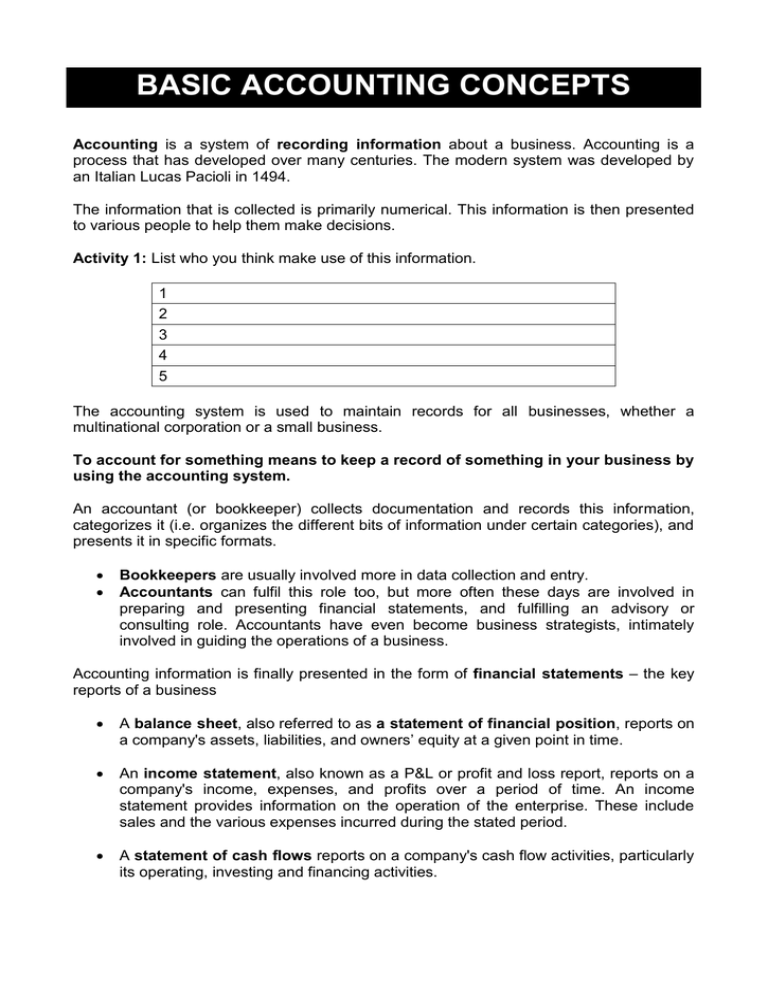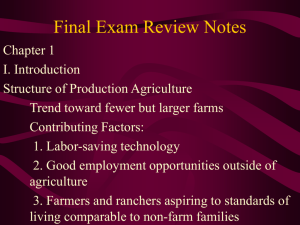Basic accounting concepts
advertisement

BASIC ACCOUNTING CONCEPTS Accounting is a system of recording information about a business. Accounting is a process that has developed over many centuries. The modern system was developed by an Italian Lucas Pacioli in 1494. The information that is collected is primarily numerical. This information is then presented to various people to help them make decisions. Activity 1: List who you think make use of this information. 1 2 3 4 5 The accounting system is used to maintain records for all businesses, whether a multinational corporation or a small business. To account for something means to keep a record of something in your business by using the accounting system. An accountant (or bookkeeper) collects documentation and records this information, categorizes it (i.e. organizes the different bits of information under certain categories), and presents it in specific formats. Bookkeepers are usually involved more in data collection and entry. Accountants can fulfil this role too, but more often these days are involved in preparing and presenting financial statements, and fulfilling an advisory or consulting role. Accountants have even become business strategists, intimately involved in guiding the operations of a business. Accounting information is finally presented in the form of financial statements – the key reports of a business A balance sheet, also referred to as a statement of financial position, reports on a company's assets, liabilities, and owners’ equity at a given point in time. An income statement, also known as a P&L or profit and loss report, reports on a company's income, expenses, and profits over a period of time. An income statement provides information on the operation of the enterprise. These include sales and the various expenses incurred during the stated period. A statement of cash flows reports on a company's cash flow activities, particularly its operating, investing and financing activities. The Accounting Equation: The single most important equation in accounting, the foundation on which everything else rests is called the Accounting Equation OWNERS’ EQUITY = ASSETS - LIABILITIES Or, as it is more commonly used in accounting: ASSETS = OWNERS’ EQUITY + LIABILITIES So what does the accounting equation mean? Well, in order to answer that question we need to look at what each of the terms in the equation mean... An ASSET is officially defined as: A resource controlled by the enterprise as a result of past events and from which future economic benefits are expected to flow to the enterprise. To put it more simply... an asset is a possession of a business that will bring the business benefits in the future. An asset is anything that will add future value to your business. Let’s look at a couple of examples: If you owned land, would it be an asset for your business? Not sure? Well, do you expect to receive benefits for your business in the future from the land? Of course. So what are the benefits it will bring? Well, you can construct a building on it that you can use for business. Even selling it would bring benefits, in the form of cash. Land = asset How about a computer that you own – is this an asset? Will it bring you benefits in the future? Well, amongst other things, you can store and retrieve large amounts of information and use it to communicate with suppliers and customers. So yes, a computer is certainly an asset. What about a motor vehicle – is this an asset? Does it have benefits for your business, and if so, what are they? Answer: Yes, there are benefits for your business... You can use the motor vehicle to pick up and deliver goods. So yes, this is also an asset. Now let’s take something more tricky – what about cash? Is cash an asset? Answer: cash is certainly an asset. What are the benefits of having cash? Simple: you can pay for things! That is certainly useful (and indeed essential) for a business. Have you ever heard of debtors? Debtors are people that owe your business money and the value of these debts as a whole. Another name for debtors is accounts receivable. The word receivable simply means capable of being received, or will be received. Would debtors or accounts receivable be an asset for your business? Answer: Even though you cannot own a debtor, you will get benefits in future from having money owed to your business. The benefits are simple – you will get paid! So if you have R3,000 owed to you by Mr. Smith, you have a debtor, an asset, worth R3,000. An additional requirement for an asset is that you have to be able to measure its value somehow and you have to be able to measure this accurately. This is usually quite simple: the value is equal to how much you paid for it. So the full test of whether something is an asset is: DOES A BUSINESS OWN/CONTROL IT? WILL IT BRING A BUSINESS BENEFITS IN THE FUTURE? CAN YOU VALUE IT ACCURATELY? If these three criteria are met, then you have an asset according to the accounting system. A LIABILITY is officially defined as: A present obligation of the enterprise arising from past events, the settlement of which is expected to result in an outflow from the enterprise of resources embodying economic benefits. In other words, a liability is simply... A debt of the business. The debt will result in assets (usually cash) leaving the business in the future. The most common liability is a loan. Another common liability is called creditors. A creditor, also known as a payable, is any business or person (apart from the bank) that you owe. Suppliers (who you owe for products purchased on credit) would fall under creditors. When you pay a loan back, or you pay off your creditors, some of your assets (most often cash) will leave your business. OWNERS’ EQUITY is officially defined as: The residual interest in the assets of the enterprise after deducting all its liabilities. That's a slightly complicated definition. Here's a simpler one: The owner’s equity is THE VALUE OF THE BUSINESS TO THE OWNER(S) In other words, it's the value of all the assets after deducting the liabilities - the value of the assets that the owner really owns. TERMINOLOGY Assets ACCOUNTING TERMINIOLOGY DEFINITION Has value and owned by the business Liabilities That which is owing by the business – money or items Expenses Paid for on a continuous / regular basis, enabling the firm to operate effectively e.g. Insurance, stationery, wages and salaries, rent, interest and discounts allowed + cost of sales Profit Income minus expenses Solvent Assets exceed liabilities Liquid Accounting equation Owners Equity Capital Drawings Entrepreneur Sole Proprietor Current assets exceed current liabilities Assets = Owner’s Equity + Liabilities (A = OE + L) Value of business to owner Owner’s Equity = Capital + Net profit - Drawings The amount of money or items of value (tangible assets) contributed to the business by the owner The amount of money or items of value withdrawn by the owner for his personal use An individual combining the other factors of production (Capital, Land and Labour) with a view to making a profit in a business venture The owner responsible for a one person business Accountant Person with specialized knowledge of commerce and finance Accounting System of recording the monetary value of business dealings Non-current asset (Fixed Asset) Current assets Non-current liabilities Current liabilities Debtor Creditor Bought for use in the business and expected to last in excess of 12 months (land and buildings, vehicles and equipment) Of value to the firm which may or may not change on a daily basis e.g. trading stock (inventory), debtors (accounts receivable) and cash (bank, petty cash, cash float) Owed by the business over a period in excess of 12 months e.g. loan and mortgage bond Amount owed that may or may not change daily as goods are bought on credit and accounts paid e.g. creditors (accounts payable), bank overdraft Someone who owes the business money Someone to whom the business owes money THE DIVISION OF ACCOUNTS WITHIN THE THREE KEY CATEGORIES: ASSETS Fixed (non-current) assets Current assets Land and buildings Trading stock Equipment Debtors Vehicles Bank Cash float Petty cash Non-current liabilities Loan Capital Drawings LIABILITIES Current liabilities Creditors Bank overdraft OWNERS EQUITY Income Sales Current income Rent income Commission received Interest on bank account Donations Interest on fixed deposit Expenses Rent expense Salaries and wages Stationery Cost of sales Rates Insurance Water and electricity Advertising Bank charges Telephone Repairs Packing material Interest on bank overdraft Donations Interest on loan There are 6 categories of accounts – (or 3 pairs of accounts): Assets (what the business owns) and Liabilities (what the business owes) Capital (what the owner(s) contribute to the business) and Drawings (what the owner(s) take from the business) Income (money earned by the business doing business) Expenses (the costs incurred by the business doing business) Activity 2: Write the correct letter in the box next to the concept: CONCEPT CORRECT ANSWER OPTIONS Asset A Book of first entry where information is recorded from the source document. Source document B Amount due to another person or business Accounting C Someone to whom the business owes money Journal D When income exceed expenses Ledger E A business that renders a service Liability F Business owned by one person Debtor G The evidence of a transaction Profit H Creditor I Owners’ Equity J Event between two or more parties K Possessions of the business L A collection of accounts of a business Transaction M Someone who owes the business money Sole trader N The interest of the owner in the business Expenses O Income P Trading concern Service undertaking A business that buys and sells merchandise for profit Amounts that generate money for the business e.g. sales Recording, reporting and interpretation of information of a business Amounts directly or indirectly involved in operating the business, e.g. telephone, stationery Activity 3: Indicate a type of account for each of the options # E.g 1 2 3 4 5 6 7 8 9 10 11 12 13 14 15 Account: Telephone Wages Rent Income Bank Insurance Advertising Creditor Current Income Stationery Cash Float Packing material Vehicle Donations received Debtor Equipment Loan Asset Expense X Income Liability Activity 4: Complete the following: 1 The money which the owner provides is called his _________________ 2. This gives the owner an interest in the business, known as _________________ 3. All money received by a business and deposited in the bank account of a business is called _________________ 4. All money paid by a business and deposited in the bank account of a business is called _________________ 5. What is relationship between the value of the assets of the business and the owner's equity? ________________________________________________________________________ ________________________________________________________________________ 6. Indicate the type of asset in each of the following examples: Motorcycle for delivery purposes _________________ Shelves, tables and chairs _________________ Computers, cash registers _________________ Desks _________________ Money in the current bank account _________________ 6. Write definitions of the following concepts: assets: __________________________________________________________________ ________________________________________________________________________ capital contribution ________________________________________________________ ________________________________________________________________________ transaction ______________________________________________________________ ________________________________________________________________________ profit ___________________________________________________________________ ________________________________________________________________________ owner's equity ____________________________________________________________ ________________________________________________________________________ payments _______________________________________________________________ ________________________________________________________________________ receipts _________________________________________________________________ ________________________________________________________________________ accounting ______________________________________________________________ ________________________________________________________________________


